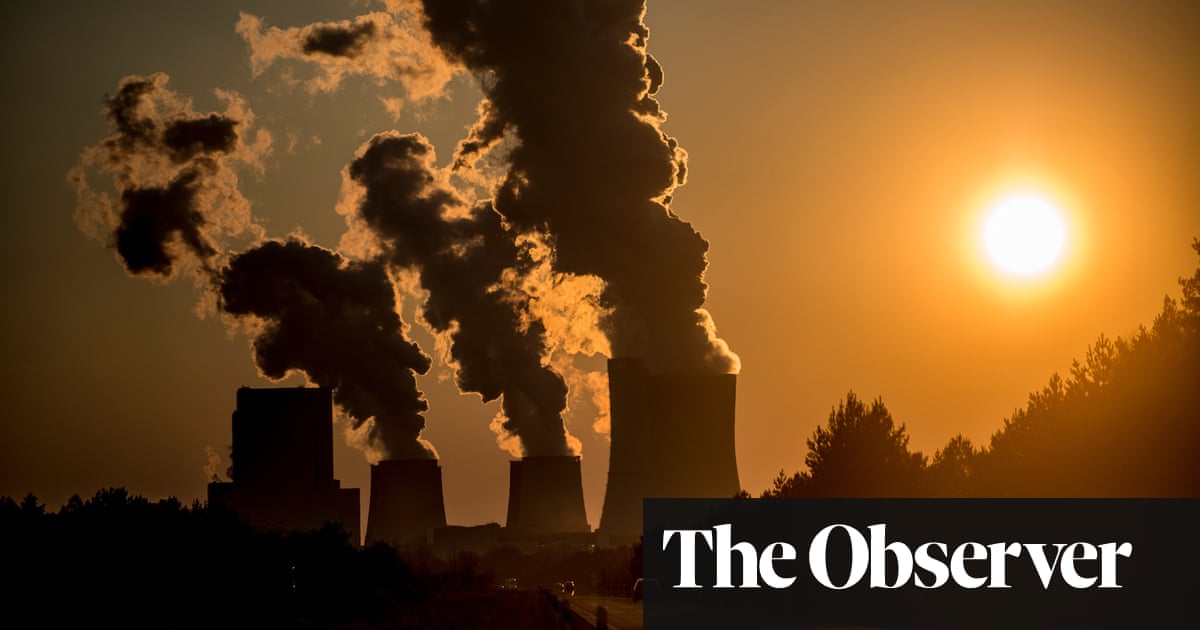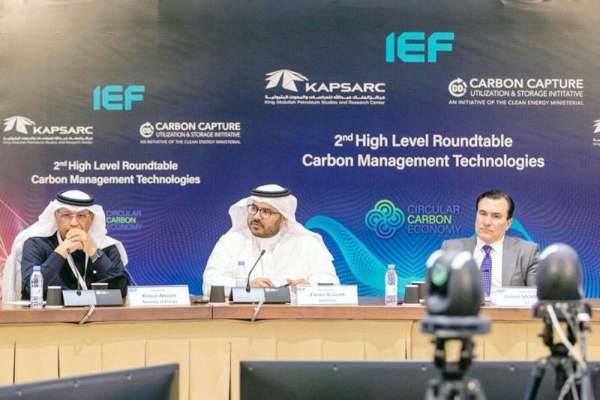
The campaign for net-zero emissions by 2050 is gaining momentum ahead of COP26 in November
Divestment of assets may burnish image of oil companies, but will not lead to desired decarbonization
BERN, Switzerland: Global warming was on the international agenda long before the UN Framework Conference on Climate Change produced the Kyoto Protocol in 1997, widely seen as a landmark for the environmental movement. But it was the Paris Agreement, signed by 196 parties at COP21 in December 2015, that promised to be the game changer.
The agreement stipulated that any rise in temperatures by the end of the century must be limited to 1.5 C above pre-industrial levels. Scientists believe that in order to achieve this the world must reach net-zero emissions by 2050, which necessitates a 45-percent carbon-emissions reduction between 2010 and 2030.
According to the World Resources Institute, 59 countries, which between them are responsible for 54 percent of global emissions, have committed to binding net-zero targets. The UAE is reportedly considering its own net-zero goal by 2050, which would make it the first OPEC state to do so.
China, the world’s biggest CO2 emitter, has pushed back its net-zero deadline to 2060, as has its neighbor Kazakhstan. Russia and India, together responsible for 11.5 percent of global CO2 emissions, have yet to make any commitment.
There is, nevertheless, considerable momentum ahead of the COP26 summit in Glasgow this November. The majority of the countries that so far have committed to net-zero targets did so in 2020. The US followed suit in 2021.
Countries and multilateral entities such as the EU have the legislative power to drive change. But if net-zero targets are to be met, civil society plays a significant role.
Greta Thunberg is a case in point. The Swedish activist’s school strikes galvanized young people around the world and influenced the political agenda of many countries. So much so that parties have had to sign up to the green agenda in order to garner votes.
However, it is undeniable that the required changes will permeate every aspect of our lives. Action is needed to eliminate coal-fired power stations; install more renewable energy sources; retrofit buildings; decarbonize cement, plastics, aviation and shipping; expand public transport networks; and shift road traffic to electric vehicles. The list goes on.
All of the above will require huge investment. Indeed, the US intends to plough a good proportion of its post-pandemic infrastructure spending into green finance.
In the GCC, Saudi Arabia is leading the way with the Saudi and Middle East Green initiatives, which aim to reduce carbon emissions by 60 percent with the help of clean hydrocarbon technologies and by planting 50 billion trees, including 10 billion in the Kingdom.
These steps were recently acknowledged by John Kerry, the US climate envoy, who had high praise for Riyadh’s plan to invest $5 billion in the world’s largest green hydrogen plant in NEOM — the smart city under construction on the Red Sea coast.
The EU’s Green Deal will similarly be financed by €600 billion from its Next Generation pandemic-recovery plan and the European Commission’s seven-year budget. The plan is aggressive in setting out how to decarbonize the economy. Given its environmental dimension, the Green Deal’s carbon border adjustment mechanism has the potential to revolutionize tariffs worldwide.
A view of vehicles stuck in a traffic jam amidst street vendors and pedlars in the central Attaba district of Egypt"s capital Cairo. (AFP/File Photo)
The price of carbon may also rise by 50 percent to €85 per ton by 2030. This is a step in the right direction, but carbon pricing will only be truly effective if it is applied globally. In which case it can become a mechanism for directing actions and allocating investments.
This is the story for rich nations with the funds and technology needed to implement rapid change. But what about the developing world, which faces significant climate threats but has limited means to adapt?
The Kyoto Protocol, the Paris Agreement and the UN’s Green Initiative obliged wealthy nations to fund climate-adaptation costs in developing countries. The Paris Agreements’ Green Climate Fund, in particular, was groundbreaking in this respect.
However, Antonio Guterres, the UN secretary-general, has had to call on rich nations to meet their $100 billion-a-year pledge to fund mitigation and adaptation measures in developing nations. According to The New York Times, only a third of this sum has actually been met.
FASTFACT
* Net zero will be achieved when all global greenhouse gases released by humans are counterbalanced by their removal from the atmosphere.
Then there are the private sources of funding behind net-zero initiatives, which are particularly important because finance is a cornerstone of the Paris Agreement, binding as it does global providers of capital into the agenda.
Environmental, social and governance (ESG) principles — the non-financial factors that investors look at when identifying risk and growth opportunities — constitute the fastest-growing asset class in the world. Deloitte expects some 50 percent, or $34.5 trillion, of all professionally managed money in the US will flow into ESG-compatible investments by 2025.
On July 7, Aviva Investors and Fidelity International, alongside another 113 investors overseeing assets worth $4.2 trillion, urged 63 of the world’s global banks to up their game on climate change, including the publication of short-term climate targets compliant with the International Energy Agency (IEA)’s net-zero scenario before annual shareholder meetings.
While this is an encouraging sign, there remain several questions about standards and so-called greenwashing. So far there are no universally agreed ESG standards, although several institutions, including the World Economic Forum (WEF), are working to create their own benchmarks.
The drive towards ESG investments channels funds towards green companies and has diminished the investor base for oil, gas and coal.
Most big companies have subscribed to net-zero 2050 targets and many European oil majors have defined themselves for some time now as ‘energy firms’ rather than oil giants, with aggressive plans to shift their activities toward renewables.
While these developments will lead to higher greener-energy production, they can also be misleading. Oil majors increasingly divest assets, which other entities, particularly in the private equity space or national oil companies, snap up on the cheap.
Shuffling the deckchairs might help improve the image of publicly listed oil companies, but it will not necessarily move more carbon out of the system.
The purists, meanwhile, want to defund hydrocarbons altogether. In May, the IEA issued a report, titled “Net Zero by 2050,” which recommended no new investments in upstream oil and gas assets after 2021.
An employee connects a Volkswagen (VW) ID.3 electric car to a loading station of German carmaker Volkswagen, at the "Glassy Manufactory" (Glaeserne Manufaktur) production site in Dresden. (AFP/File Photo)
It says clean-energy investment needs to triple to $4 trillion by 2030. Although well-intentioned, the proposal is much more feasible for developed countries, which can afford measures like the electrification of road traffic. But in developing countries, where almost 800 million people have no access to electricity, gas is still needed as an affordable transition fuel.
The IEA report also said the new green economy could create 30 million jobs. It was unrealistic, however, when it calculated job losses of 5 million. In some of the world’s developing countries, many more than this number work in the coal sector alone.
Also, many Western governments underestimate the role that carbon capture, use and storage (CCUS) will play in decarbonization of the economy. The concept of the circular carbon economy, which will reduce reuse, recycle and remove carbon, and which was endorsed by the G20, could be better appreciated by decision makers.
Furthermore, nobody has yet compiled a full environmental and economic analysis of the life cycle of various sources of energy. A failure to understand their impact could lead to policy failures and the misallocation of funds.
In all of the above, clear and predictable regulatory frameworks are essential if initiatives are to win the backing of investors. In other words, expect the journey to net zero to be bumpy, occasionally acrimonious, and not as straightforward as many would like.
------------
* Cornelia Meyer is a Ph.D.-level economist with 30 years of experience in investment banking and industry. She is chairperson and CEO of business consultancy Meyer Resources. Twitter: @MeyerResources











